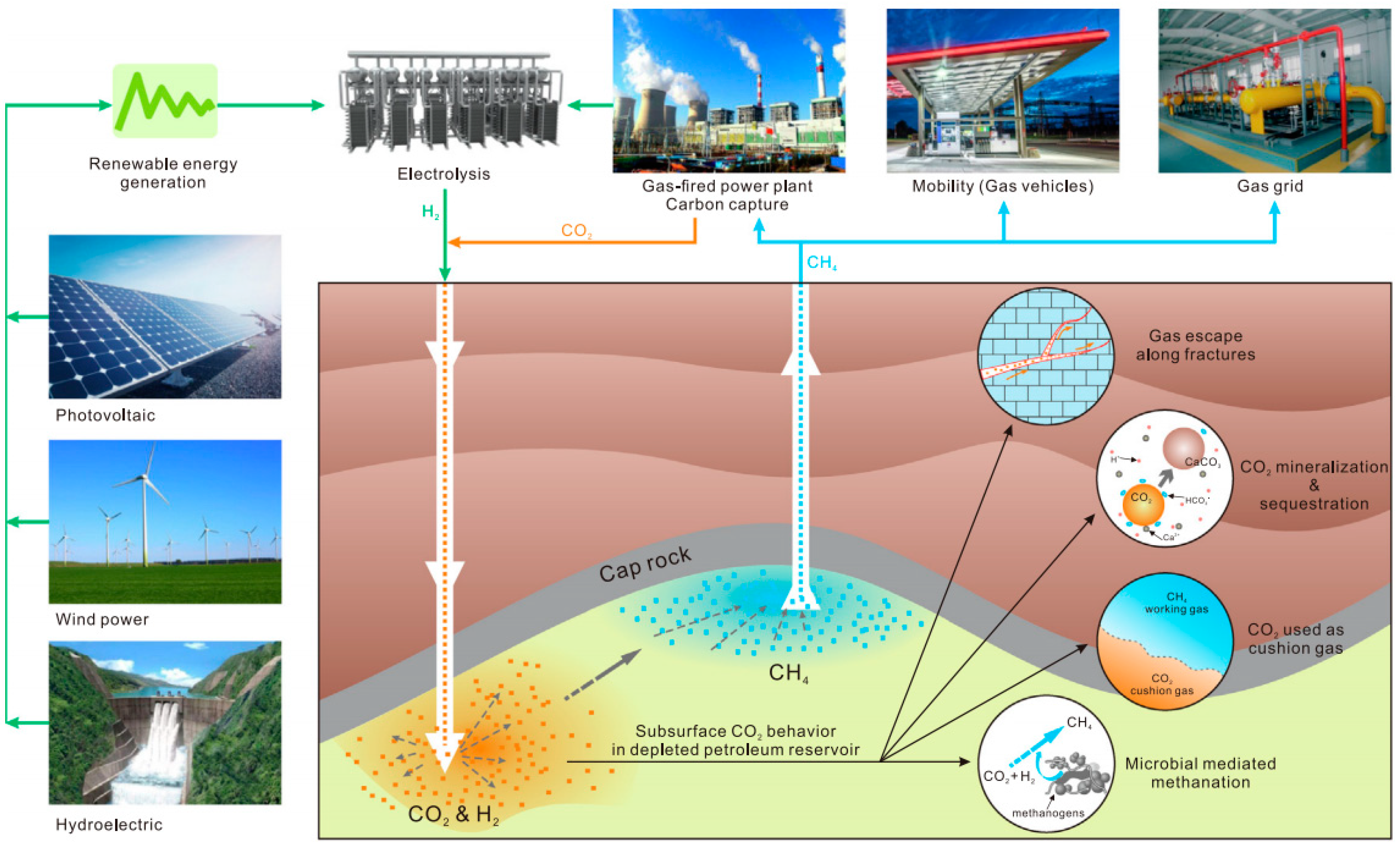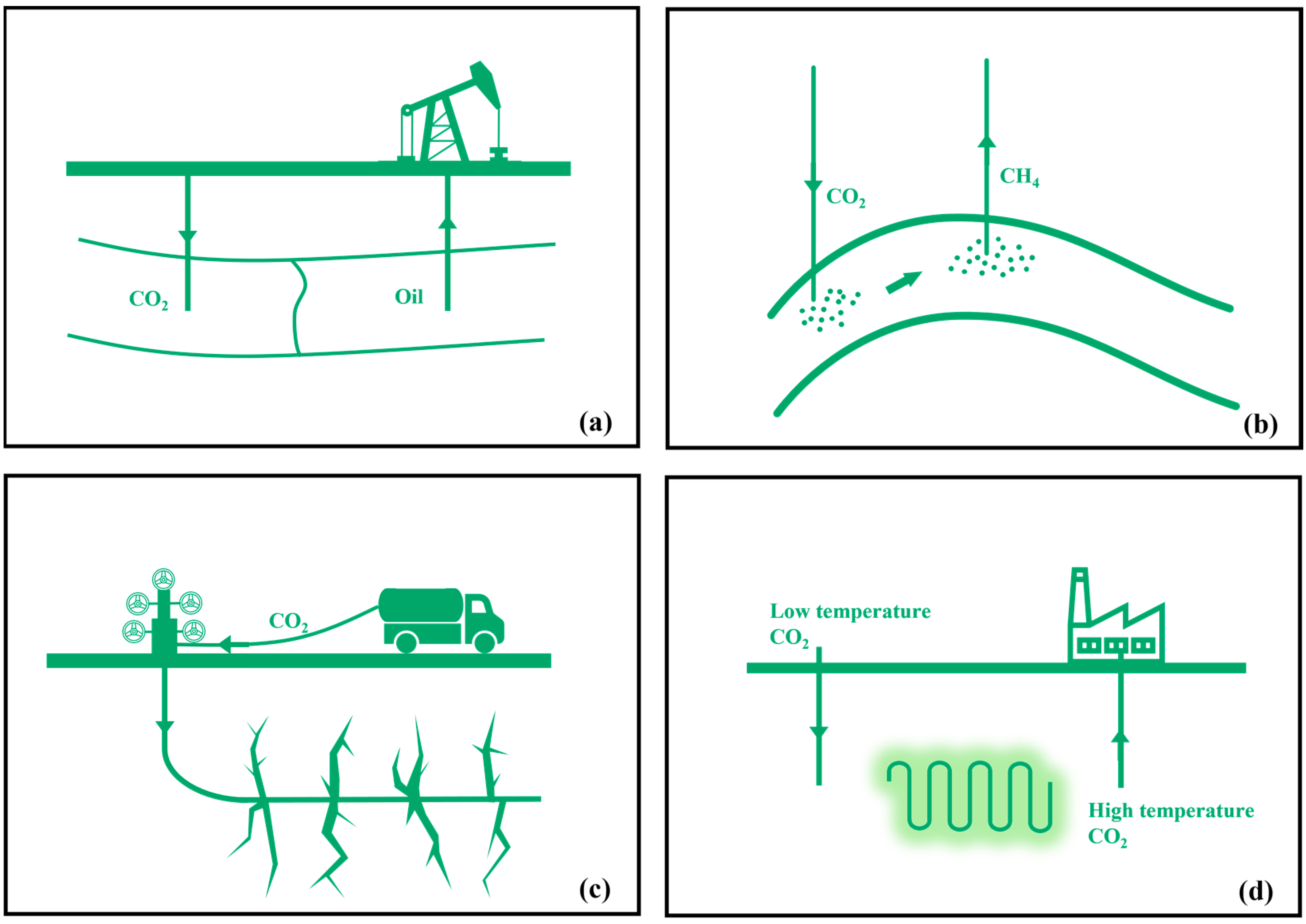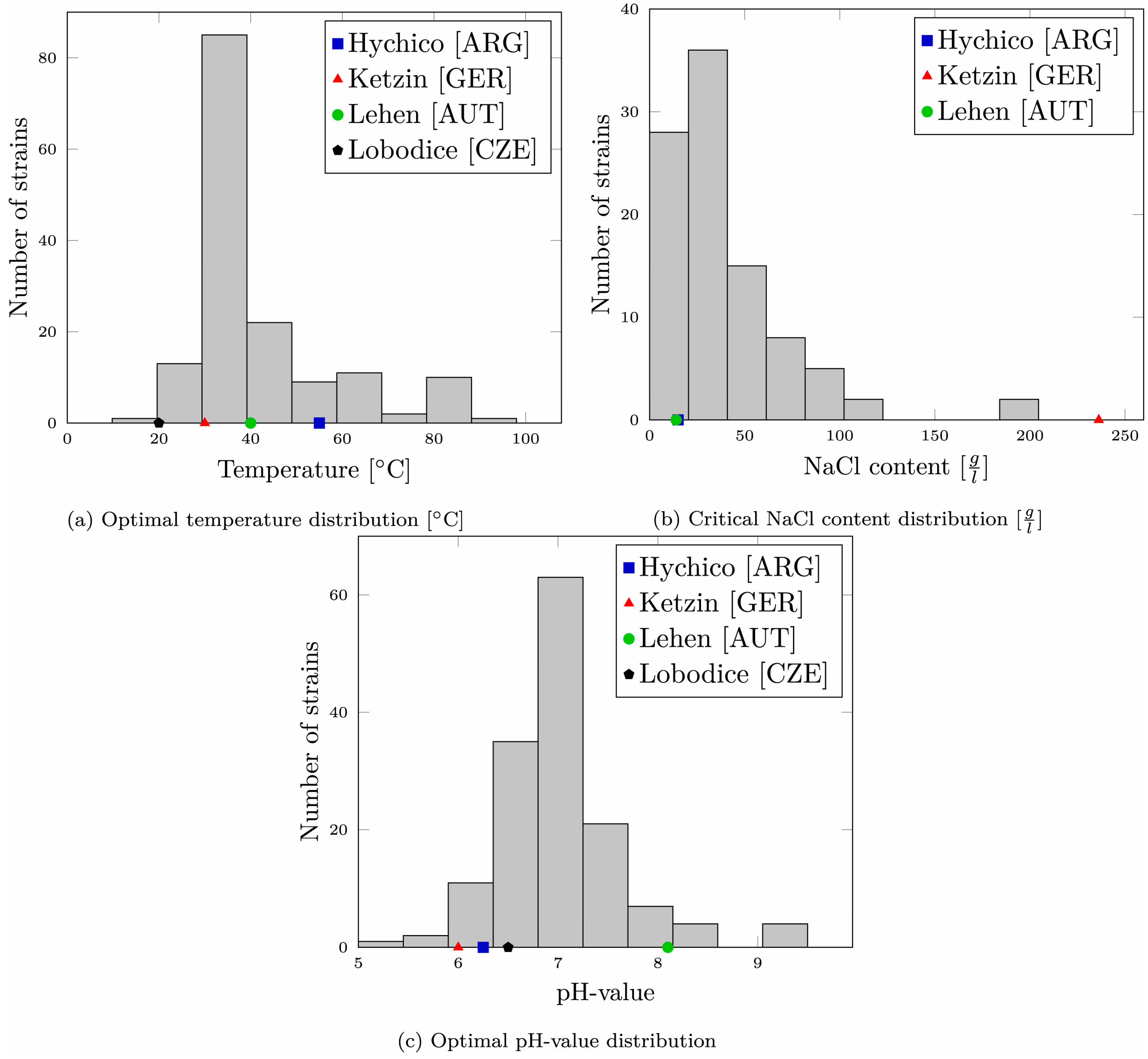Carbon Circular Utilization and Partially Geological Sequestration: Potentialities, Challenges, and Trends
Abstract
:1. Introduction
2. CU/CCU
3. Geological CCUS
3.1. CO2-EOR
- (1)
- Control the cost of the overall industrial chain covering carbon capture and carbon transportation to improve economics.
- (2)
- Reservoir screening and evaluation (seepage and storage conditions, mechanical and chemical properties).
- (3)
- Stable carbon source and large-scale CO2 transport technology.
- (4)
- Underground carbon dioxide monitoring technologies and anti-corrosion, anti-blocking pipes, operating strategies, and service life extension.
- (5)
- Infrastructure investments, such as pipelines and surface separation and recycling facilities for CO2, should be improved.
3.2. CO2-EGR
- (1)
- Key technologies (e.g., CO2 breakthrough) and engineering parameters should be overcome and optimized to improve technical maturity.
- (2)
- Reservoir storage capacity assessment and evaluation of site selection criteria.
- (3)
- Similarly, the amount of CO2 consumed by EGR poses specific demands on the carbon source, as well as sufficient and cost-effective CO2 is the basis for the commercialization of CO2-EGR.
- (4)
- Monitoring technology of downhole CO2 and anti-corrosion and anti-blocking technologies of equipment and pipelines.
3.3. CO2 Fracturing
- (1)
- The fracturing mechanisms still need to be further investigated, including supercritical carbon dioxide fracturing initiation and fracture expansion mechanism.
- (2)
- The improvement of sand-carrying ability and the development of a thickening agent, resistance-reducing agent, and new lightweight proppant.
- (3)
- Precision phase control and strict requirements of equipment sealing and corrosion resistance.
- (4)
- Cost control and economics for large-scale industrial applications.
3.4. CO2-EGS
- (1)
- Reasonable and acceptable CO2 capture cost is a necessary prerequisite for CO2 application in geology.
- (2)
- The potential threats of CO2 leakage during storage in deep formations have been the major constraints in promoting CO2 geological storage techniques.
- (3)
- Complex phase transition mechanisms and migration processes of CO2 in geothermal reservoirs.
- (4)
- Generation of large-area hydraulic fracture network and heat exchange surface.
4. CCCUS

- (1)
- Screening of specific strains and large-scale efficient and low-cost nurture.
- (2)
- Dynamic tracking and monitoring system for biochemical catalytic reaction processes.
- (3)
- Unknown biochemical processes and influencing factors in real reservoirs.
- (4)
- Activation and control of microbial populations in the reservoir environment and inhibition of competing organisms.
- (5)
- Energy conversion efficiency and site selection and evaluation criteria.
- (6)
- Uncertainty of economic benefits, operating mechanisms, and business models. It is needed for quantitative financial model assessment on field tests (the Sichuan Province of China is suitable for such tests) to find the appropriate business mechanism.
- (7)
- The full supply chain of hydrogen, including production (cost-effective, method, etc.), transportation (related materials, mode, etc.), and storage (corrosion, leakage, etc.) are also key issues of CCCUS.
5. Outlook
Author Contributions
Funding
Data Availability Statement
Conflicts of Interest
References
- Kweku, D.W.; Bismark, O.; Maxwell, A.; Desmond, K.A.; Danso, K.B.; Oti-Mensah, E.A.; Quachie, A.T.; Adormaa, B.B. Greenhouse effect: Greenhouse gases and their impact on global warming. J. Sci. Res. Rep. 2018, 17, 1–9. [Google Scholar] [CrossRef]
- Kazemifar, F. A review of technologies for carbon capture, sequestration, and utilization: Cost, capacity, and technology readiness. Greenh. Gases Sci. Technol. 2021, 12, 200–230. [Google Scholar] [CrossRef]
- National Oceanic and Atmospheric Administration. Carbon Dioxide Now More than 50% Higher than Pre-Industrial Levels. Available online: https://www.noaa.gov/news-release/carbon-dioxide-now-more-than-50-higher-than-pre-industrial-levels (accessed on 6 June 2022).
- Lowe, R.; Drummond, P. Solar, wind and logistic substitution in global energy supply to 2050–Barriers and implications. Renew. Sustain. Energy Rev. 2022, 153, 111720. [Google Scholar] [CrossRef]
- Schleussner, C.-F.; Rogelj, J.; Schaeffer, M.; Lissner, T.; Licker, R.; Fischer, E.M.; Knutti, R.; Levermann, A.; Frieler, K.; Hare, W. Science and policy characteristics of the Paris Agreement temperature goal. Nat. Clim. Chang. 2016, 6, 827–835. [Google Scholar] [CrossRef] [Green Version]
- Change, P.C. Global Warming of 1.5 °C; World Meteorological Organization: Geneva, Switzerland, 2018. [Google Scholar]
- Roelfsema, M.; Fekete, H.; Höhne, N.; den Elzen, M.; Forsell, N.; Kuramochi, T.; de Coninck, H.; van Vuuren, D.P. Reducing global GHG emissions by replicating successful sector examples: The ‘good practice policies’ scenario. Clim. Policy 2018, 18, 1103–1113. [Google Scholar] [CrossRef] [Green Version]
- Yu, L.; Zhao, L. Research on China’s Energy External Dependence and Energy Strategy. E3S Web Conf. 2021, 245, 01047. [Google Scholar]
- Xie, Y.; Qi, J.; Zhang, R.; Jiao, X.; Shirkey, G.; Ren, S. Toward a Carbon-Neutral State: A Carbon–Energy–Water Nexus Perspective of China’s Coal Power Industry. Energies 2022, 15, 4466. [Google Scholar] [CrossRef]
- Wang, J.; Feng, L.; Palmer, P.I.; Liu, Y.; Fang, S.; Bosch, H.; O’Dell, C.W.; Tang, X.; Yang, D.; Liu, L.; et al. Large Chinese land carbon sink estimated from atmospheric carbon dioxide data. Nature 2020, 586, 720–723. [Google Scholar] [CrossRef]
- Our World in Data. China: CO2 Country Profile; Our World in Data: Oxford, UK, 2020. [Google Scholar]
- BoFeng, C.; Li, Q.; Zhang, Q. China Carbon Dioxide Capture Utilization and Storage (CCUS) Annual Report (2021)—China CCUS Pathway Study; Ministry of Ecology and Environment, Chinese Academy of Sciences, The Administrative Center for China’s Agenda 21: Beijing, China, 2021. (In Chinese) [Google Scholar]
- Xie, Y.; Hou, Z.; Liu, H.; Cao, C.; Qi, J. The sustainability assessment of CO2 capture, utilization and storage (CCUS) and the conversion of cropland to forestland program (CCFP) in the Water–Energy–Food (WEF) framework towards China’s carbon neutrality by 2060. Environ. Earth Sci. 2021, 80, 468. [Google Scholar] [CrossRef]
- Agency, I.E. Putting CO2 to Use-Creating Value from Emissions; International Energy Agency (IEA): Paris, France, 2019. [Google Scholar]
- Luo, J.; Hou, Z.; Feng, G.; Liao, J.; Haris, M.; Xiong, Y. Effect of Reservoir Heterogeneity on CO2 Flooding in Tight Oil Reservoirs. Energies 2022, 15, 3015. [Google Scholar] [CrossRef]
- Kuuskraa, V.A.; Godec, M.L.; Dipietro, P. CO2 utilization from “next generation” CO2 enhanced oil recovery technology. Energy Procedia 2013, 37, 6854–6866. [Google Scholar] [CrossRef]
- Hamza, A.; Hussein, I.A.; Al-Marri, M.J.; Mahmoud, M.; Shawabkeh, R.; Aparicio, S. CO2 enhanced gas recovery and sequestration in depleted gas reservoirs: A review. J. Pet. Sci. Eng. 2021, 196, 107685. [Google Scholar] [CrossRef]
- Nianyin, L.; Jiajie, Y.; Chao, W.; Suiwang, Z.; Xiangke, L.; Jia, K.; Yuan, W.; Yinhong, D. Fracturing technology with carbon dioxide: A review. J. Pet. Sci. Eng. 2021, 205, 108793. [Google Scholar] [CrossRef]
- Zhang, L.; Li, X.; Zhang, Y.; Cui, G.; Tan, C.; Ren, S. CO2 injection for geothermal development associated with EGR and geological storage in depleted high-temperature gas reservoirs. Energy 2017, 123, 139–148. [Google Scholar] [CrossRef]
- Ferguson, R.C.; Nichols, C.; Van Leeuwen, T.; Kuuskraa, V.A. Storing CO2 with enhanced oil recovery. Energy Procedia 2009, 1, 1989–1996. [Google Scholar] [CrossRef] [Green Version]
- Cooney, G.; Littlefield, J.; Marriott, J.; Skone, T.J. Evaluating the climate benefits of CO2-enhanced oil recovery using life cycle analysis. Environ. Sci. Technol. 2015, 49, 7491–7500. [Google Scholar] [CrossRef]
- Ghedan, S.G. Global laboratory experience of CO2-EOR flooding. In Proceedings of the SPE/EAGE Reservoir Characterization and Simulation Conference, Abu Dhabi, United Arab Emirates, 19–21 October 2009; OnePetro: Richardson, TX, USA, 2009. [Google Scholar]
- Andrei, M.; De Simoni, M.; Delbianco, A.; Cazzani, P.; Zanibelli, L. Enhanced oil recovery with CO2 capture and sequestration. In Proceedings of the Conference: 21st World Energy Congress (WEC) 2010, Montreal, QC, Canada, 12–16 September 2010. [Google Scholar]
- Alfarge, D.; Wei, M.; Bai, B. CO2-EOR mechanisms in huff-n-puff operations in shale oil reservoirs based on history matching results. Fuel 2018, 226, 112–120. [Google Scholar] [CrossRef]
- Jia, B.; Tsau, J.-S.; Barati, R. A review of the current progress of CO2 injection EOR and carbon storage in shale oil reservoirs. Fuel 2019, 236, 404–427. [Google Scholar] [CrossRef]
- Hill, B.; Hovorka, S.; Melzer, S. Geologic carbon storage through enhanced oil recovery. Energy Procedia 2013, 37, 6808–6830. [Google Scholar] [CrossRef] [Green Version]
- Liu, Z.-x.; Liang, Y.; Wang, Q.; Guo, Y.-j.; Gao, M.; Wang, Z.-b.; Liu, W.-l. Status and progress of worldwide EOR field applications. J. Pet. Sci. Eng. 2020, 193, 107449. [Google Scholar] [CrossRef]
- Wei, N.; Li, X.; Dahowski, R.T.; Davidson, C.L.; Liu, S.; Zha, Y. Economic evaluation on CO2-EOR of onshore oil fields in China. Int. J. Greenh. Gas Control 2015, 37, 170–181. [Google Scholar] [CrossRef]
- Al-Hasami, A.; Ren, S.; Tohidi, B. CO2 injection for enhanced gas recovery and geo-storage: Reservoir simulation and economics. In Proceedings of the SPE Europec/EAGE Annual Conference, Madrid, Spain, 13–16 June 2005; OnePetro: Richardson, TX, USA, 2005. [Google Scholar]
- Kühn, M.; Förster, A.; Großmann, J.; Lillie, J.; Pilz, P.; Reinicke, K.; Schäfer, D.; Tesmer, M.; Partners, C. The Altmark natural gas field is prepared for the enhanced gas recovery pilot test with CO2. Energy Procedia 2013, 37, 6777–6785. [Google Scholar] [CrossRef] [Green Version]
- Odi, U. Analysis and potential of CO2 Huff-n-Puff for near wellbore condensate removal and enhanced gas recovery. In Proceedings of the SPE Annual Technical Conference and Exhibition, San Antonio, TX, USA, 8–10 October 2012; OnePetro: Richardson, TX, USA, 2012. [Google Scholar]
- Clemens, T.; Secklehner, S.; Mantatzis, K.; Jacobs, B. Enhanced gas recovery, challenges shown at the example of three gas fields. In Proceedings of the SPE Europec/Eage Annual Conference and Exhibition, Barcelona, Spain, 14–17 June 2010; OnePetro: Richardson, TX, USA, 2010. [Google Scholar]
- Khan, C.; Amin, R.; Madden, G. Carbon dioxide injection for enhanced gas recovery and storage (reservoir simulation). Egypt. J. Pet. 2013, 22, 225–240. [Google Scholar] [CrossRef] [Green Version]
- Klimkowski, Ł.; Nagy, S.; Papiernik, B.; Orlic, B.; Kempka, T. Numerical simulations of enhanced gas recovery at the Załęcze gas field in Poland confirm high CO2 storage capacity and mechanical integrity. Oil Gas Sci. Technol. Rev. d’IFP Energ. Nouv. 2015, 70, 655–680. [Google Scholar] [CrossRef] [Green Version]
- Eliebid, M.; Mahmoud, M.; Shawabkeh, R.; Elkatatny, S.; Hussein, I.A. Effect of CO2 adsorption on enhanced natural gas recovery and sequestration in carbonate reservoirs. J. Nat. Gas Sci. Eng. 2018, 55, 575–584. [Google Scholar] [CrossRef]
- Zhang, R.; Yin, X.; Winterfeld, P.H.; Wu, Y.-S. A fully coupled thermal-hydrological-mechanical-chemical model for CO2 geological sequestration. J. Nat. Gas Sci. Eng. 2016, 28, 280–304. [Google Scholar] [CrossRef] [Green Version]
- Luo, Z.; Wu, L.; Zhao, L.; Zhang, N.; Chen, W.; Liang, C. Numerical study on filtration law of supercritical carbon dioxide fracturing in shale gas reservoirs. Greenh. Gases Sci. Technol. 2021, 11, 871–886. [Google Scholar] [CrossRef]
- Gundogan, O.; Mackay, E.; Todd, A. Comparison of numerical codes for geochemical modelling of CO2 storage in target sandstone reservoirs. Chem. Eng. Res. Des. 2011, 89, 1805–1816. [Google Scholar] [CrossRef]
- Fan, C.; Elsworth, D.; Li, S.; Zhou, L.; Yang, Z.; Song, Y. Thermo-hydro-mechanical-chemical couplings controlling CH4 production and CO2 sequestration in enhanced coalbed methane recovery. Energy 2019, 173, 1054–1077. [Google Scholar] [CrossRef]
- Wang, M.; Huang, K.; Xie, W.; Dai, X. Current research into the use of supercritical CO2 technology in shale gas exploitation. Int. J. Min. Sci. Technol. 2019, 29, 739–744. [Google Scholar] [CrossRef]
- Wu, L.; Hou, Z.; Luo, Z.; Xiong, Y.; Zhang, N.; Luo, J.; Fang, Y.; Chen, Q.; Wu, X. Numerical simulations of supercritical carbon dioxide fracturing: A review. J. Rock Mech. Geotech. Eng. 2022. [Google Scholar] [CrossRef]
- Wang, F.; Wang, Y.; Zhu, Y.; Duan, Y.; Chen, S.; Wang, C.; Zhao, W. Application of liquid CO2 fracturing in tight oil reservoir. In Proceedings of the SPE Asia Pacific Oil & Gas Conference and Exhibition, Perth, Australia, 25–27 October 2016; OnePetro: Richardson, TX, USA, 2016. [Google Scholar]
- US Energy Information Administration (EIA). Drilling Productivity Report; EIA: Washington, DC, USA, 2022. [Google Scholar]
- Olasolo, P.; Juárez, M.; Morales, M.; Liarte, I. Enhanced geothermal systems (EGS): A review. Renew. Sustain. Energy Rev. 2016, 56, 133–144. [Google Scholar] [CrossRef]
- Haris, M.; Hou, M.Z.; Feng, W.; Luo, J.; Zahoor, M.K.; Liao, J. Investigative coupled thermo-hydro-mechanical modelling approach for geothermal heat extraction through multistage hydraulic fracturing from hot geothermal sedimentary systems. Energies 2020, 13, 3504. [Google Scholar] [CrossRef]
- Li, D.; Wang, Y. Major issues of research and development of hot dry rock geothermal energy. Earth Sci 2015, 40, 1858–1869. [Google Scholar]
- Harto, C.; Schroeder, J.; Horner, R.; Patton, T.; Durham, L.; Murphy, D.; Clark, C. Water Use in Enhanced Geothermal Systems (EGS): Geology of US Stimulation Projects, Water Costs, and Alternative Water Source Policies; Argonne National Lab. (ANL): Argonne, IL, USA, 2014. [Google Scholar]
- Wang, X.-x.; Wu, N.-y.; Su, Z.; Zeng, Y.-c. Progress of the enhanced geothermal systems (EGS) development technology. Prog. Geophys. 2012, 27, 355–362. [Google Scholar]
- Brown, D.W. A hot dry rock geothermal energy concept utilizing supercritical CO2 instead of water. In Proceedings of the Twenty-Fifth Workshop on Geothermal Reservoir Engineering, Stanford University, Stanford, CA, USA, 24–26 January 2000; pp. 233–238. [Google Scholar]
- Randolph, J.B.; Saar, M.O. Combining geothermal energy capture with geologic carbon dioxide sequestration. Geophys. Res. Lett. 2011, 38. [Google Scholar] [CrossRef] [Green Version]
- Hou, J.; Cao, M.; Liu, P. Development and utilization of geothermal energy in China: Current practices and future strategies. Renew. Energy 2018, 125, 401–412. [Google Scholar] [CrossRef]
- China Geological Survey. China Geothermal Energy Development Report; China Petrochemical Press: Beijing, China, 2018. [Google Scholar]
- Amigáň, P.; Greksak, M.; Kozánková, J.; Buzek, F.; Onderka, V.; Wolf, I. Methanogenic bacteria as a key factor involved in changes of town gas stored in an underground reservoir. FEMS Microbiol. Ecol. 1990, 6, 221–224. [Google Scholar]
- Gmw. With an Annual Output of about 33 Million Tons, China Has Become the World’s Largest Hydrogen Producer. 2021. Available online: https://ptx-hub.org/factsheet-on-china-the-worlds-largest-hydrogen-producer-and-consumer/ (accessed on 21 December 2022).
- Xiong, Y.; Hou, Z.; Xie, H.; Zhao, J.; Tan, X.; Luo, J. Microbial-mediated CO2 methanation and renewable natural gas storage in depleted petroleum reservoirs: A review of biogeochemical mechanism and perspective. Gondwana Res. 2022. [Google Scholar] [CrossRef]
- Strobel, G.; Hagemann, B.; Huppertz, T.M.; Ganzer, L. Underground bio-methanation: Concept and potential. Renew. Sustain. Energy Rev. 2020, 123, 109747. [Google Scholar] [CrossRef]
- Thaysen, E.M.; McMahon, S.; Strobel, G.J.; Butler, I.B.; Ngwenya, B.T.; Heinemann, N.; Wilkinson, M.; Hassanpouryouzband, A.; McDermott, C.I.; Edlmann, K. Estimating microbial growth and hydrogen consumption in hydrogen storage in porous media. Renew. Sustain. Energy Rev. 2021, 151, 111481. [Google Scholar] [CrossRef]
- Middleton, R.S.; Carey, J.W.; Currier, R.P.; Hyman, J.D.; Kang, Q.; Karra, S.; Jiménez-Martínez, J.; Porter, M.L.; Viswanathan, H.S. Shale gas and non-aqueous fracturing fluids: Opportunities and challenges for supercritical CO2. Appl. Energy 2015, 147, 500–509. [Google Scholar] [CrossRef] [Green Version]
- Haris, M.; Hou, M.Z.; Feng, W.; Mehmood, F.; bin Saleem, A. A regenerative Enhanced Geothermal System for heat and electricity production as well as energy storage. Renew. Energy 2022, 197, 342–358. [Google Scholar] [CrossRef]


| Items | Description |
|---|---|
| Underground structure | Trapping (e.g., anticline and fault) and impermeable cap rock |
| Porosity | Minimum: 10% |
| Permeability | Minimum: 10 mD |
| Water saturation | Minimum: 10% |
| Temperature | Survival range: 15–98 °C; favorable range: 30–70 °C |
| pH | Survival range: 4–9.5; favorable range: 6.5–7.5 |
| Salinity | Maximum: 150 g/L |
| Technical Type | Main Characteristics | Technology Maturity | Potential | |
|---|---|---|---|---|
| CU/CCU | Direct or conversion utilization | CO2 fixation is simple and convenient | Mature | CO2 consumption: 6.2 × 107 t~8.7 × 107 t |
| Geological CCUS | EOR | Large-scale, partially permanent sequestration of CO2, more economical than pure CO2 sequestration | Almost mature | CO2 storage: 5.1 × 109 t |
| EGR | Almost mature | CO2 storage: 9.0 × 109 t | ||
| Fracturing | Pilot stage | CO2 consumption: 1 × 108 t~1.5 × 108 t | ||
| Geothermal | Theoretical stage | CO2 consumption: 3.3 × 107 t~6.6 × 107 t | ||
| CCCUS | Underground Biomethanation | Designed carbon sink, large scale, low cost of underground methanation, storage of renewable methane, carbon circular economy | Theoretical stage | CO2 consumption: 5.94 × 108 t~7.98 × 108 t Energy storage: 3.29 × 1012 kWh~4.42 × 1012 kWh |
Disclaimer/Publisher’s Note: The statements, opinions and data contained in all publications are solely those of the individual author(s) and contributor(s) and not of MDPI and/or the editor(s). MDPI and/or the editor(s) disclaim responsibility for any injury to people or property resulting from any ideas, methods, instructions or products referred to in the content. |
© 2022 by the authors. Licensee MDPI, Basel, Switzerland. This article is an open access article distributed under the terms and conditions of the Creative Commons Attribution (CC BY) license (https://creativecommons.org/licenses/by/4.0/).
Share and Cite
Hou, Z.; Luo, J.; Xie, Y.; Wu, L.; Huang, L.; Xiong, Y. Carbon Circular Utilization and Partially Geological Sequestration: Potentialities, Challenges, and Trends. Energies 2023, 16, 324. https://doi.org/10.3390/en16010324
Hou Z, Luo J, Xie Y, Wu L, Huang L, Xiong Y. Carbon Circular Utilization and Partially Geological Sequestration: Potentialities, Challenges, and Trends. Energies. 2023; 16(1):324. https://doi.org/10.3390/en16010324
Chicago/Turabian StyleHou, Zhengmeng, Jiashun Luo, Yachen Xie, Lin Wu, Liangchao Huang, and Ying Xiong. 2023. "Carbon Circular Utilization and Partially Geological Sequestration: Potentialities, Challenges, and Trends" Energies 16, no. 1: 324. https://doi.org/10.3390/en16010324
APA StyleHou, Z., Luo, J., Xie, Y., Wu, L., Huang, L., & Xiong, Y. (2023). Carbon Circular Utilization and Partially Geological Sequestration: Potentialities, Challenges, and Trends. Energies, 16(1), 324. https://doi.org/10.3390/en16010324








